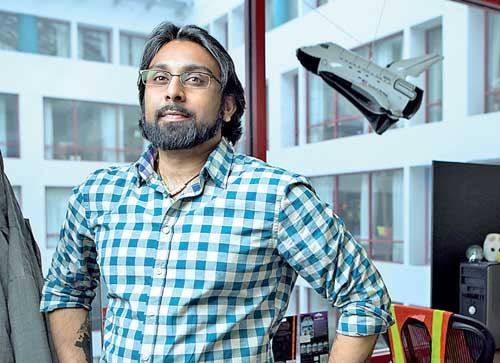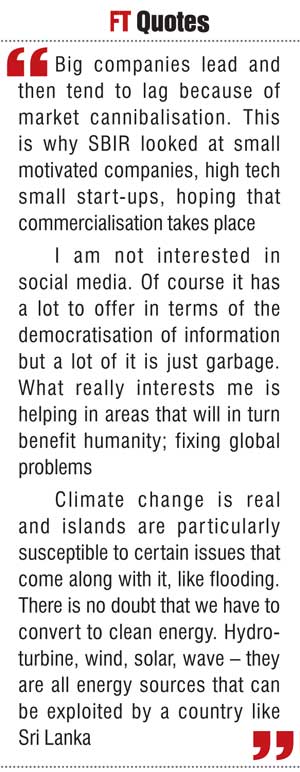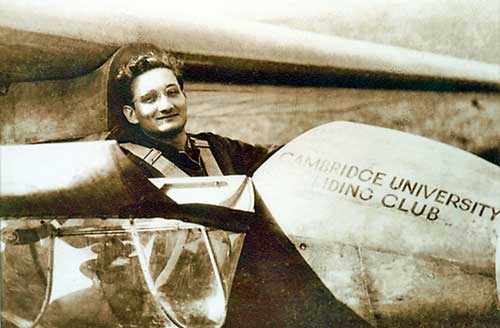Thursday Jan 09, 2025
Thursday Jan 09, 2025
Friday, 17 June 2016 00:00 - - {{hitsCtrl.values.hits}}
By Malik Gunatilleke
The IESL Ray Wijewardene Memorial Lecture will be delivered later this month by 2016 USA Eisenhower Fellow, engineer and IP-legal advisor G. Nagesh Rao on matters pertaining to the state of innovation ecosystems.
Rao is a multi-faceted thought leader with titles that include technologist, commercialisation strategist, entrepreneur and policy expert, with experience in fields such as science, law, business, public policy, renewable energy and agriculture.

He serves as the Chief Technologist and Entrepreneur in Residence with the US Small Business Administration’s Office of Investment & Innovation with involvement in the execution and oversight of the annual $ 25 billion seed fund of the Small Business Innovation Research (SBIR) program. He also serves on President Barack Obama’s Lab to Market Commercialisation Interagency Policy Committee which accelerates the transfer of federally-funded research from the laboratory to the commercial marketplace, which is known as the “Lab-to-Market” agenda.
At the centre of all of his many iterations, exists what Rao admits is the core precept of his operational agenda. Driven by his thirst for knowledge, he simply wants to find lasting solutions to the world’s biggest and most pressing problems – an ideology shared by SBIR.
In between attending meetings during his visit to Vietnam earlier this month, Rao was able to speak to the Daily FT about his impending first-time visit to Sri Lanka and his endeavours related to disruptive innovation.
Innovation through empowering small businesses
The roots of the SBIR program date back to the ’70s when US President Jimmy Carter expressed an interest in viable research and technology which led to the SBIR program being established in 1982. The SBIR was set up as the US seed fund program in order for domestic small businesses to engage in research and development that has a strong potential for commercialisation. The program focuses on stimulating technological innovation, meeting federal development needs, increasing private sector commercialisation through federal funds and fostering innovation in small, under-privileged businesses.
“Big companies lead and then tend to lag because of market cannibalisation. This is why SBIR looked at small motivated companies, high tech small start-ups, hoping that commercialisation takes place,” he stated.
Over the last 30-plus years, SBIR has provided in excess of $ 40 billion to small businesses while handling around 50,000 patents – amounting to around seven a day – with numerous success stories including the likes of Biogen and Symantec.
Much like Rao’s personal tenets, SBIR also focuses its support on long term projects that are intent on assisting large populations, steering away from modern-day technological moneymaking ventures.
“I am not interested in social media. Of course it has a lot to offer in terms of the democratisation of information but a lot of it is just garbage. What really interests me is helping in areas that will in turn benefit humanity; fixing global problems. SBIR has assisted in industries that create life-saving drugs to one that focus on space exploration.”
SBIR also does not take equity from the businesses they choose to assist and neither do they hold any percentage of ownership of the company or its technology. Rao stated that SBIR considers its return on investment to be the jobs it creates and the mobilisation of innovation and technology.
“We own nothing and really don’t want to. All we want in return is the feedback. We want them to go out and evangelise and inspire the next generations of innovators. We need to embrace that next level of innovation and work towards scaling it up.”
Disruptive innovations
In the field of disruptive innovations – technology that disrupts existing market and value networks, often replacing them with long term and sustainable networks – mobile wireless technology is a subject of great interest to SBIR and Rao personally.
Growing up in India, Rao explains that communication technology was in its infancy whereas at present, mobile technology has covered most parts of the world and has seeped into almost all walks of life with countries like South Korea leading the way.
Over the past few years, Sri Lanka has become a testing ground for the latest technologies, including mobile wireless tech. The most significant development in this regard was when in July last year, Google signed an agreement with Sri Lanka’s Information and Communication Technology Agency (ICTA) to launch its Project Loon technology on a mass scale in the country which would provide internet access to rural areas, making Sri Lanka only the second country in the world to get full internet coverage using LTE.
Rao in turn stated that he sees vast potential in Sri Lanka’s ability to be a test bed for new technologies. He stated that Sri Lanka’s testing bed environment would mean that the country would have a first to market advantage in infiltrating new technological trends with nanotechnology being a particularly promising area of potential for Sri Lanka.
“The next big thing is smart software coupled with smart hardware –the internet of things. Asia is fast becoming a hub for innovative technology and Sri Lanka has the potential to be at the forefront of it,” he said.
Rao was particularly impressed with the country’s innovations in the garment industry in which it has emerged as a global leader. As an advisor to several entrepreneurial programs and agencies including MAS Holdings, Rao stated that although he had never visited Sri Lanka in person before, his knowledge of some of the amazing technology used by the leaders in garments had led him to believe that this was another area in which Sri Lanka could lead.
Sri Lanka and clean energy
Clean energy was also a topic of discussion and Rao believes that Sri Lanka’s unique positioning as well as its geographical features may set the stage for the little island to become a global leader in clean energy.
“Climate change is real and islands are particularly susceptible to certain issues that come along with it, like flooding. There is no doubt that we have to convert to clean energy. Hydro-turbine, wind, solar, wave – they are all energy sources that can be exploited by a country like Sri Lanka. Innovators in this field such as Altaeros Energy are SBIR-funded projects and have made great leaps with clean energy tech that can easily be implemented in Sri Lanka,” he said.
Altaeros Energy has developed a hovering wind turbine called BAT or the Buoyant Airborne Turbine which harnesses more consistent and eight to 10 times more powerful winds at altitudes as high as 1,000 to 2,000 feet above ground level. A helium inflated shell lifts a lightweight turbine into the air while high-strength conductive tethers are used to send power back to the ground. Rao believes that technology such as this could easily be deployed in Sri Lanka.
“There are terawatts of unused energy just flying above us. Constant wind streams thousands of feet above ground level. It’s a perfect solution for a coastal country. These turbines could be tethered to skyscrapers in the city as well for constant electricity generation while bypassing logistical concerns,” he added.
IESL Ray Wijewardene Memorial Lecture
Rao will travel to Sri Lanka to deliver the IESL Ray Wijewardene Memorial Lecture 2016 on the theme of ‘Road Mapping the Future: State of Innovation Ecosystems’ on 24 June at the Institution of Engineers Sri Lanka (IESL) auditorium.
His lecture will tackle how the nexus of science, technology, business, law, art and people, cultivate a thriving and sustainable innovation ecosystem.
While praising the legacy of Ray Wijewardene and his impact on agro-technology, aviation and domestic entrepreneurship, Rao commended the Ray Wijewardene Trust for its work in Sri Lanka, adding that it was a great honour to be asked to deliver the lecture.
During his 15-day visit, beginning on 19 June, Rao will travel to many parts of the island including Dambulla, Colombo and the hill country. Apart from delivering the memorial lecture, he will also meet with fellow innovators, high-tech entrepreneurs, leaders, politicians, Government officials and officials from MAS Holdings as well as the Sri Lanka Institute of Nanotechnology (SLINTEC).
He will also review the country’s technological ecosystem as part of a fact finding mission with the aim of connecting Sri Lankan entrepreneurs to US companies and vice versa.
- Pic by Willis Bretz (http://www.willisbretz.com/)
Ray Wijewardene was a Sri Lankan engineer, pioneer, entrepreneur, inventor and Olympian athlete who, along with his illustrious career, had an extremely diverse personality. He was a man driven by his passion for sustainable agriculture and left behind a legacy of innovation and engineering brilliance that captivated and inspired generations of young inventors in Sri Lanka.
In 1955, Wijewardene looked critically and scientifically at the farming practices prevailing at the time and invented the world’s first two-wheeled tractor, calling it the Landmaster. His breakthrough invention, in the years that followed, sold over 300,000 units in 27 countries including Sri Lanka, the UK, Australia, the Philippines, Malaysia and Japan.
According to him, an invention was only a lab idea. Although these ideas can be demonstrated, it didn’t mean that it can be taken straight away to the market. The next step was innovation, which is the process by which you take the invention to the point where it can be widely demonstrated; the next stage is building a prototype and finally a business plan so that it can become a bankable project.
The Ray Wijewardene Charitable Trust (RWCT) was set up in honour of the great inventor in order to recognise and support innovation in the fields of sustainable agriculture, renewable energy, engineering and aeronautics – all disciplines that were pursued and encouraged by Wijewardene. The RWCT through the memorial lecture hopes to encourage and inspire entrepreneurship and with its ‘The Ray’ award hopes to find the next Ray Wijewardene in Sri Lanka.
The RWCT in partnership with the British Council and TVE Asia Pacific launched the late Ray Wijewardene’s official website www.raywijewardene.net. The website records the work of the illustrious Sri Lankan engineer and inventor, his achievements and accolades. In addition to its role as a memorial and a way of promoting his vision for self-reliance, innovation and sustainable development in Sri Lanka, the site serves as an important interface for interaction with the RWCT.